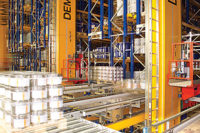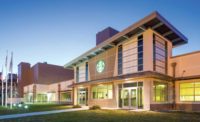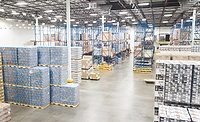Space, automation drive new beverage facility needs
Distributor consolidation continues to impact warehouse operations

HDA Architects is working with 7G Distributing to replace its existing operation with a new 112,000-square-foot offi ce and warehouse, featuring insulated concrete precast panels with a large scaled company logo painted on two sides of the building. (Image courtesy of HDA Architects)
The educational videos from “Schoolhouse Rock!” helped make it easier for young students to learn about President Thomas Jefferson’s deal with France to acquire the Louisiana Territory in 1803: “Oh, elbow room, elbow room, got to, Got to get us some elbow room.”
Although not as expansive as the Louisiana Purchase, beverage manufacturers and distributors also have felt the need to gain “elbow room.” Through new facility development, some beverage operators are dedicating their capital expenditure budget to the construction of new plants and offices. However, the reasons for turning to new facilities remains as diverse as the operators’ portfolios.
“Companies that need large square footage or a highly customized facility are opting for new facilities,” says Lloyd Snyder Sr., vice president of Portland, Maine-based Woodard & Curran. “In some cases, large companies are consolidating their smaller inefficient facilities into large world-class facilities. In other cases, a company is seeking to add more production into a geography that they previously underserved and are seeing improved distribution costs.”
Snyder adds that lower distribution costs, and a larger and educated labor resource pool sometimes is not as easily attained when renovating older facilities. “Many older facilities are landlocked and the manufacturer needs to build a large facility to gain economies of scale,” he says. “Retrofitting existing facilities does not solve the fundamental problems of distribution and labor pool.”
Chet Willey, owner of Arlington, Texas-based Chet Willey Associates (CWA), highlights SKU proliferation among the biggest drivers for new facility builds. “I think the average beer wholesaler increases SKUs by an average of 100 per year,” he explains.
Jack Holleran, president of St. Louis-based HDA Architects, also notes the impact of SKU growth in beer and non-alcohol beverage sectors, coupled with limited space in an existing facility to accommodate those SKUs.
The following are additional factors that Holleran lists as motivators for new facility builds:
- The existing building and site have been maxed out;
- An antiquated facility, which might have low clear height, limited dock doors, and an inability to expand the warehouse;
- Maintenance issues with roof, mechanical systems, floor, doors and technology;
- Limited productivity improvements without more space; and
- Because the company is working out of multiple facilities.
No matter what the deciding factors are, an analysis can be valuable when evaluating new build versus retrofit, Holleran notes.
“We always study first the existing building before a new facility, and often it can be renovated to extend its life three to five years or more,” he says.
However, analysis can prove that a new facility can be necessary. HDA recently announced that it is working with Davenport, Iowa-based 7G Distributing to replace its existing operation with a nearby new 112,000-square-foot office and warehouse.
“The 14.6-acre development will include a warehouse and a connected two-story office building,” the company states in a release. “The facility will feature insulated concrete precast panels with a large scaled company logo painted on two sides of the building.”
Relating back to the multiple facility factor, CWA’s Willey explains that increased distributor consolidation within the past few years is motivating beverage operators to bring all operations into one unit.
“People, when they merge or consolidate, they don’t want to operate out of two facilities,” he explains. “In many cases, they might use one for storage and one for a pick area, so that they can combine all the products on one truck. That doesn’t work for too long because it’s hard to manage transferring the products, so I think that drives a new facility as much as anything.”
The automation factor
As beverage manufacturers and distributors look to streamline operations, more are turning to automation as a solution. However, this, too, can influence facility building decisions.
“Robotics, machine learning and artificial intelligence are poised to disrupt the industry in the years to come, and the continued evolution of these technologies will literally shape manufacturing’s long-term future,” Woodard & Curran’s Snyder explains. “These all drive flexibility that is paramount in design today. Companies want to be able to create new packages driven by marketing trends with little change to the packaging line. This means equipment manufacturers are using quick changeover techniques and wider use of automated controls, electronic servos and robotics.”
At Woodard & Curran, the firm implements and integrates these projects to reflect trends that it sees in respective industries. These insights are among the benefits of design-lead builds’ partnerships, he notes.
“Robotics costs are coming down and making projects more viable to reduce manpower costs and produce a more consistent product,” Snyder explains. “Increasingly, engineering firms are being selected to lead design-build projects because the innovative technical solutions drive the project execution.”
When reviewing automation solutions for new facility planning, experts also highlight the complementary benefits that beverage manufacturers and distributors can reap from automated storage and retrieval systems (AS/RS).
For example, greater clear ceiling heights, which can result in less floor area, support AS/RS operations, HDA’s Holleran says.
Among HDA’s current projects, the architect design build company was engaged by Fisher59, Denton, Texas, to design a 203,000-square-foot corporate headquarters and beverage distribution facility. To achieve efficient product storage and movement, the facility is employing the latest in AS/RS technology, the company says.
CWA’s Willey, who is working with HDA on the Fisher59 project, also notes the necessity of high ceiling heights when utilizing AS/RS technology in a facility. “What we see is if you’re using something like an automatic and retrieval system, then the height of the ceiling is the biggest factor,” he says.
Environmental influence
When going through the planning stages of a new facility build, companies might also opt to re-evaluate their sustainability goals, experts note. Depending on what focus a beverage operator would like to employ, numerous solutions can be implemented as part of a new facility design.
“[A] sustainable facility is one that produces their products in a manner that is favorable to sustaining the world (replenishment, efficiency and reuse of materials and energy),” Woodard & Curran’s Snyder says. “We see beverage plants focused on water reuse and waste minimization. Sustainable energy, for example, solar does play a part, but [is] much less significant.”
In addition to rain water reclamation, HDA’s Holleran notes that rooftop solar panels, light sensors, HVAC controls, insulated building envelop, large fan systems to reduce energy costs and LED lighting are popular sustainability solutions that beverage manufacturers and distributors are employing.
For aspects such as LED lighting and solar panels, CWA’s Willey notes that cost and state incentives likely are contributing to the implementation of these sustainability solutions. BI
Looking for a reprint of this article?
From high-res PDFs to custom plaques, order your copy today!







